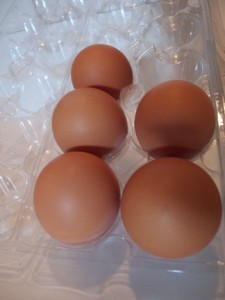I think most people can agree that a hen that gets to walk around lives a more pleasant life than a hen that lives in a tiny cage. When you go to the grocery store it is hard to sift through the different egg carton labels to determine which eggs are the best for you.
Here is a brief description of the different labels compiled with the help of the Humane Society’s publication on egg carton labeling. Only 3 labels show an adherence to official, audited guidelines. Those labels will be shown underlined. Although there are guidelines for what the hens eat, there really aren’t audited guidelines for how they are treated. California just passed a prevention of cruelty to farm animals, which gives hope that other states will follow. It could also be incentive to have backyard hens of your own!
- Certified Organic – Organic hens are fed vegetarian, organic feed that is free of antibiotics and pesticides. The hens live barns and warehouses (and not in cages) and are required to have access to the outdoors. If you read The Omnivore’s Dilemma, you will come to understand that the gray area here is the term “access to the outdoors”. The outdoors can mean a beautiful pasture or a paved area. The farmers can keep the chicks strictly indoors fortheir first 5 weeks of life, after which they open the barn doors. At this point the chickens are so used to life indoors that they are often too afraid to venture outside. Beak cutting and forced molting (via starvation) are allowed.
- Free-Range/Free-Roaming – There are no USDA standards for “free-range” egg production. They aren’t caged, but are subject to the same conditions as above and there’s no standards as to how many chickens are in stocked in a given space. There are no standards as to what the birds are fed. Beak cutting and forced molting (via starvation) are allowed.
- Certified Humane – These hens are kept out of cages, but may be indoors all the time. They have to be allowed to perform what comes naturally to them such as dust bathing, perching and nesting. There are requirements as to stocking density, number of nest boxes and perches. Debeaking is allowed, but forced molting isn’t.
- Cage Free – These birds are kept out of cages, but may be indoors all the time. They are able to do some of what comes naturally to them (walking, spreading their wings and nesting). Debeaking and forced molting are permitted.
- Vegetarian-Fed – These birds are fed a diet that doesn’t include any recycled animals. However, there are no guidelines for their housing and care.
- Natural – There is no legal definition of “natural”. Any food that doesn’t contain artificial ingredients or added color, and is minimally processed is considered “natural”
- Omega-3 Enriched – This usually means that the hens were fed extra flax seed causing their eggs to be higher in Omega 3s. There are no guidelines for their housing and care.
- Fertile – The eggs were laid by hens who come into contact with roosters, which generally means they weren’t caged.
- United Egg Producers Certified – This is a voluntary program that most egg farmers comply with. It permits cruel and inhumane practices. The hens are given 67 square inches of space each, which isn’t enough for them to perform their natural behaviors (stretching their wings, walking, etc.). They are allowed to debeak the hens, but forced molting through starvation isn’t allowed. Compliance is verified through 3rd party auditing.


Pingback: Prosthelytzing and Vilifying | Brooklyn Feed
Pingback: Brooklyn Free Range Chickens | Brooklyn Feed